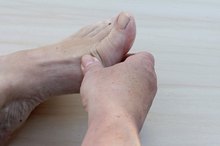Underarm Shooting Pain
Underarm or armpit pain can be caused by a variety of reasons 2. By taking note of the specific type of pain you experience, you can help your physician diagnose your condition faster. A cerebrovascular accident, heartburn, peripheral artery disease, neuropathy issues or a swollen underarm lymph node can cause sharp, shooting pain in your armpit area 2. The pain is not a disease in itself but a sign that alerts you to a number of different issues within your body. It is best to consult with your physician, especially when the pain is recurring and unbearable.
If you are experiencing serious medical symptoms, seek emergency treatment immediately.
Cerebrovascular Accident
When you experience a cerebrovascular accident, certain portions of your brain may be damaged, which can cause headaches, dizziness or the overall faulty operation of certain brain functions. Nerve endings in your underarm area may be the victim of this type of damage, which can manifest itself through a painful, electric-current-like sensation of pain in your armpits.
Neuropathy
Neurological Disorders That Have Symptoms of Electrical Shock Feelings
Learn More
Issues with your nerves can cause very sharp, shooting pain radiating from your underarm up to the inner section of your elbow. Neuropathy issues can stem from a variety of causes, such as adult chicken pox or vitamin B complex deficiency. Essentially, the nerves misfire because of some minor damage, producing radiating pain.
Swollen Lymph Nodes
Swollen lymph nodes mean that there is an ongoing fight between your white blood cells and an invading bacteria or virus in your body. Lymph nodes are collections of white blood cells. When they are fighting an infection, more white blood cells are produced, thus enlarging the lymph nodes and making them appear swollen.
Heartburn
What Are the Causes of Burning Sensations in the Inner Thigh?
Learn More
Heartburn is a form of indigestion in which your stomach acids travel upward. The burn travels through the esophagus and sometimes up towards your heart area, giving the impression that your heart is burning. This heat can sometimes extend to your underarm region, where a sharp pain can be felt, which often goes away after a minute or two.
- Heartburn is a form of indigestion in which your stomach acids travel upward.
- This heat can sometimes extend to your underarm region, where a sharp pain can be felt, which often goes away after a minute or two.
Peripheral Artery Disease
Peripheral artery disease is an obstruction of any of the arteries outside of those found near the heart or the brain. This includes arteries running through your arms and legs, which can also become clogged and hamper proper blood flow. When this happens in the area near your shoulders or armpits, it manifests itself through a sharp pain that can spread from the underarms to the rest of the shoulder area.
- Peripheral artery disease is an obstruction of any of the arteries outside of those found near the heart or the brain.
- When this happens in the area near your shoulders or armpits, it manifests itself through a sharp pain that can spread from the underarms to the rest of the shoulder area.
Related Articles
References
- Health and Nutrition Tips: Armpit Pain
- Armpit Pain: Swollen Armpit
- Kruger SJ. Breast cancer presenting as subclavian/axillary deep vein thrombosis and upper limb lymphoedema. Ann R Coll Surg Engl. 2012;94(2):e55-6. doi:10.1308/003588412X13171221500745
- Mohseni S, Shojaiefard A, Khorgami Z, Alinejad S, Ghorbani A, Ghafouri A. Peripheral lymphadenopathy: approach and diagnostic tools. Iran J Med Sci. 2014;39(2 Suppl):158-70.
- Calgüneri M, Oztürk MA, Ozbalkan Z, et al. Frequency of lymphadenopathy in rheumatoid arthritis and systemic lupus erythematosus. J Int Med Res. 2003;31(4):345-9. doi:10.1177/147323000303100415
- Kumar PA, Islary B, Ramachandra R, Naik T. Axillary Nerve Schwannoma: A Rare Case Report. Asian J Neurosurg. 2017;12(4):787-789. doi:10.4103/1793-5482.181147
- Vinkel C, Thomsen SF. Hidradenitis Suppurativa: Causes, Features, and Current Treatments. J Clin Aesthet Dermatol. 2018;11(10):17-23.
- Badri T, Sliti N, Benmously R, et al. [Erythrasma: study of 16 cases]. Tunis Med. 2014;92(4):245-8.
- Marulli G, Battistella L, Mammana M, Calabrese F, Rea F. Superior sulcus tumors (Pancoast tumors). Ann Transl Med. 2016;4(12):239. doi:10.21037/atm.2016.06.16
- Nair PA, Patel BC. Herpes Zoster (Shingles). StatPearls Publishing. Updated May 6, 2019.
- Park JE, Sohn YM, Kim EK. Sonographic findings of axillary masses: what can be imaged in this space? J Ultrasound Med. 2013;32(7):1261-70. doi:10.7863/ultra.32.7.1261
- Kayıran O, De la cruz C, Tane K, Soran A. Lymphedema: From diagnosis to treatment. Turk J Surg. 2017;33(2):51-57. doi:10.5152/turkjsurg.2017.3870
- Evangelista LS, Sackett E, Dracup K. Pain and heart failure: unrecognized and untreated. Eur J Cardiovasc Nurs. 2009;8(3):169-73. doi:10.1016/j.ejcnurse.2008.11.003
- Figueira PVG, Haddad CAS, De almeida rizzi SKL, Facina G, Nazario ACP. Diagnosis of Axillary Web Syndrome in Patients After Breast Cancer Surgery: Epidemiology, Risk Factors, and Clinical Aspects: A Prospective Study. Am J Clin Oncol. 2018;41(10):992-996. doi:10.1097/COC.0000000000000411
- Kasper, Dennis L.., Anthony S. Fauci, and Stephen L.. Hauser. Harrison's Principles of Internal Medicine. New York: Mc Graw Hill education, 2015. Print.
- Kumar, Vinay, Abul K. Abbas, and Jon C. Aster. Robbins and Cotran Pathologic Basis of Disease. Philadelphia: Elsevier-Saunders, 2015. Print.
Writer Bio
Cindy Hamilton is the creator of Family-Health-And-Nutrition.com. Hamilton has been writing on the topic of healthy living on a budget since 2007 and has been featured on Mamapedia.com. In 2009 Family-Health-And-Nutrition.com was named one of the 100 best websites for healthy parents by onlinenursingprograms.net. Hamilton holds a Bachelor of Science from Capital University in Columbus, Ohio.








